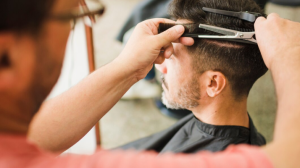Finasteride Results Timeline: What to Expect
If you’ve looked into hair loss treatments, you’ve likely come across finasteride, an FDA-approved prescription medication. The effectiveness of finasteride is supported by numerous scientific studies that show real, measurable improvements in hair count and density.
However, it’s important to keep in mind that results won’t appear overnight — finasteride is a long-term solution. Typically, it takes a few months before you begin noticing improvements in healthy hair growth and overall density.
Below, we’ll discuss how long finasteride takes to show results and outline the typical timeline for seeing progress after starting treatment.
How Long Does It Take for Finasteride to Show Results?
Finasteride is a medication that belongs to a class called 5-alpha reductase inhibitors. It works by blocking the enzyme 5-alpha-reductase, which converts testosterone into dihydrotestosterone (DHT). DHT is a hormone responsible for male pattern baldness (androgenetic alopecia) and conditions like benign prostatic hyperplasia (BPH).
Although finasteride starts to lower DHT levels in the body shortly after you take your first dose, it typically takes around three to four months of consistent use to see visible results in terms of hair growth. Full results usually become apparent after about one year of regular use.
Why Does Finasteride Take Time to Work?
The hair on your scalp grows in cycles, and each hair follicle follows its own schedule. The hair growth cycle consists of four phases: anagen (growth phase), catagen (transition phase), telogen (resting phase), and exogen (shedding phase). Finasteride helps to extend the anagen phase, allowing hair to grow longer and thicker. Since it takes time for new hairs to grow from the root and become visible, you won’t see immediate results even though the medication is working internally from the start.
Finasteride Results Timeline
Here’s a detailed breakdown of what you can expect when taking finasteride:
Months 1 to 3: Initial Changes
During the first few months, finasteride starts to lower DHT levels significantly—by about 65% within 24 hours of the first dose. This reduction helps protect your hair follicles from further damage caused by DHT. However, you may not notice any visible changes in your hair during this period. Many people mistakenly believe the medication isn’t working and consider stopping, but it’s crucial to continue daily use, as the drug is working behind the scenes.
Months 3 to 6: Early Results
Most people start to notice some improvement in hair growth and thickness between three to six months of consistent use. You may see a reduction in hair loss, particularly around the hairline and crown. Clinical studies have shown that by 12 weeks, many men experience significant improvements, but these are still early results.
Month 12: Noticeable Improvement
After one year of daily use, you should see a substantial increase in hair density and reduced hair loss. Studies show that about 65% of men experience new hair growth after 12 months of finasteride use. Hair will appear thicker, and previously thinning areas may show visible improvement. Even if your hair growth has not dramatically increased, finasteride will likely have stabilized your hair loss, preventing further thinning.
Long-Term Results: Beyond 12 Months
Finasteride continues to work effectively beyond the 12-month mark. Research indicates that men who use finasteride for two to five years experience sustained or even increased hair growth and density. For example, a two-year study showed a 16% increase in hair count, and a five-year study from Japan found that 99.4% of men using finasteride had noticeable improvements in hair thickness and coverage.

How to Maximize Finasteride Results
To get the best results from finasteride, consider the following tips:
- Consistency is Key: Take finasteride daily, as prescribed. Skipping doses can reduce its effectiveness and delay results.
- Combine with Minoxidil: Using finasteride alongside minoxidil can provide even better results. Minoxidil, a topical treatment, enhances blood flow to hair follicles and complements finasteride’s DHT-blocking effects.
- Use DHT-Blocking Shampoo: Consider adding a DHT-blocking shampoo to your hair care routine. These shampoos can help reduce scalp DHT levels and promote healthier hair growth.
- Monitor Progress: Take monthly photos of your hairline and scalp under the same lighting conditions. This will help you track progress and stay motivated, as hair growth changes can be gradual and hard to notice on a day-to-day basis.
- Continue Long-Term Use: Once you achieve desired results, continue taking finasteride to maintain them. Stopping the medication can lead to a resurgence of DHT and subsequent hair loss.
Comparing Finasteride with Other Hair Loss Treatments
While finasteride is a highly effective treatment for hair loss, it’s not the only option available. Here’s a quick comparison with other treatments:
- Minoxidil: An over-the-counter topical solution that stimulates hair growth by improving blood flow to the scalp. It’s often used together with finasteride for a more comprehensive approach to treating hair loss.
- Hair Transplants: A more invasive, yet effective, option for restoring hair in areas of significant thinning or baldness. While the results are more immediate and permanent, hair transplants are costly and require surgical intervention.
- Laser Therapy: Low-level laser therapy devices are available for home use and may help stimulate hair follicles and improve hair density.
Bottom Line: What to Expect with Finasteride
Finasteride is a powerful tool for combating hair loss, but patience and consistency are essential. Although it starts working immediately to lower DHT levels, visible results typically take three to six months to appear, with full effects seen after one year. Long-term use can help maintain these results and even further improve hair density and growth.
If you’re looking to combat hair loss, finasteride could be a beneficial part of your treatment plan. For best results, speak to a healthcare professional about your hair loss concerns, and consider combining finasteride with other treatments like minoxidil or hair care products specifically designed for hair loss prevention.






